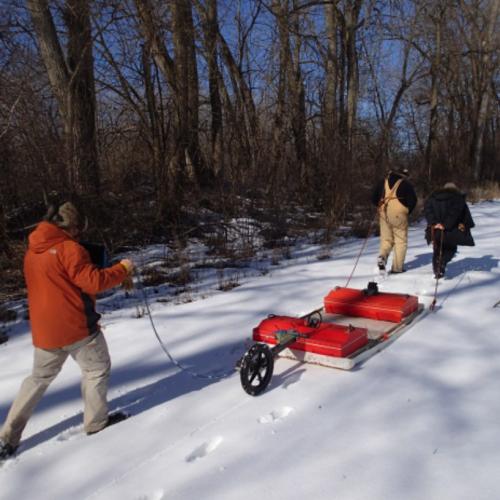The New York State Geological Survey over the past five years has actively been developing three-dimensional mapping protocols and products. Producing accurate and reliable surficial deposits maps traditionally involves a high labor, low efficiency methods utilizing evaluation of outcrops and exposures, hand augers and sediment classification, thus the production of one 7.5 minute quadrangle (approximately six miles by eight miles) can easily consume two years’ worth of field work. In an effort to improve accuracy and efficiency in map production we utilize ground penetrating radar (GPR) to dovetail with traditional methods to remotely sense and characterize unconsolidated glacial deposits and determine stratigraphy (layering within deposits) that comprises the geologic framework.
Originally GPR developed for measuring the thickness of glaciers in the 1930s, the hardware and software made tremendous technological advances in the 1960s, 1970s and finally became affordable in the mid 1980s. Ground penetrating radar utilizes electromagnetic (radio waves) to penetrate the subsurface and produce reflections of targets similar to seismic surveys for oil and gas. The difference is that GPR has much higher resolution and is easier to process the data and render subsurface images, takes less time, and is less costly. Coarse-grained, low conductivity deposits such as sand & gravel are ideal deposits to map in detail with GPR as opposed to clay rich deposits that absorb and limit signal penetration. Antenna frequency determines the level of resolution and signal penetration. In general, low frequency antennas can penetrate deeper into the earth but cannot resolve smaller targets and high frequency antennas provide better resolution but perform at a much shallower depth. We utilize frequencies in the 400 -100 MHz range for deep (25-60 feet) geological mapping whereas the vast majority of GPR surveys utilize 2.0 GHz for internal surveying of concrete and infrastructure work (3-6 inches).
GPR has been used to: map megafaunal remains, find unmarked graves, map foundations and archaeological features, conduct forensics, locate infrastructure, and identify subsurface geologic hazards.





